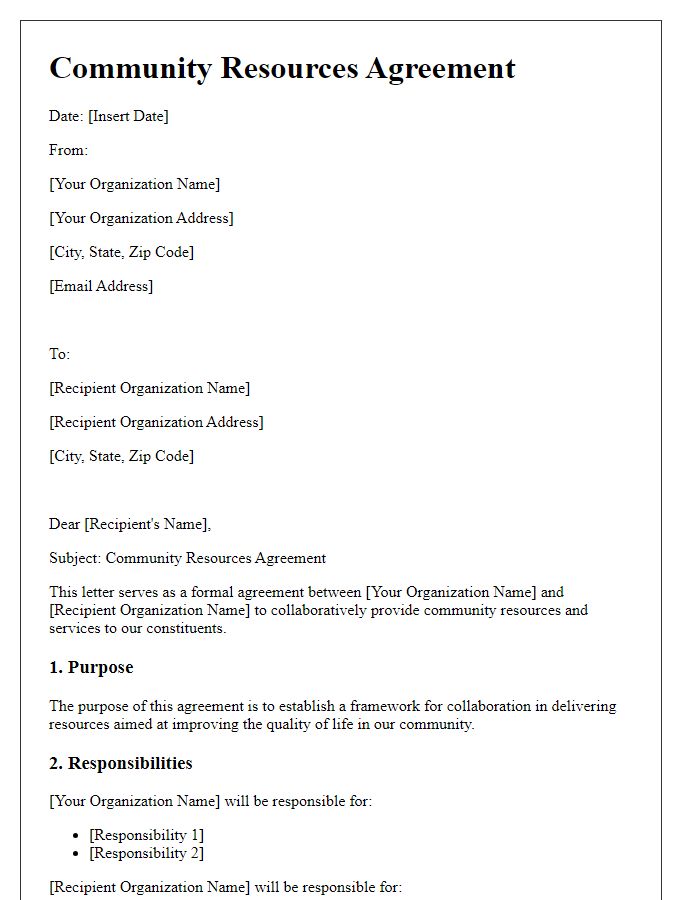Are you looking to foster a stronger bond within your community through a development agreement? Drafting such a letter can be a crucial step in outlining the partnership between stakeholders and ensuring that everyone's voice is heard. Creating a clear and constructive agreement lays the groundwork for collaborative growth and mutual benefits. Dive into our article for expert tips and a comprehensive template to help you get started!

Introduction and Purpose
A community development agreement (CDA) serves as a formal document outlining the collaborative intentions and responsibilities among stakeholders within a specific location, such as a city or neighborhood, aiming to foster socioeconomic growth and sustainability. The primary purpose of a CDA is to establish clear goals and mutual commitments for projects, ranging from affordable housing initiatives to public infrastructure enhancements. These agreements often involve various entities, including local government agencies, community organizations, and private developers, ensuring that the needs and insights of the community members, especially marginalized groups, are prioritized in the planning and execution of developmental projects. Through this cooperative framework, CDAs facilitate transparent communication, enhance resource allocation, and encourage active participation from all parties involved, ultimately leading to strengthened community ties and improved living conditions.
Roles and Responsibilities
Community development agreements outline the essential roles and responsibilities of various stakeholders in a project aimed at improving local living conditions and fostering sustainable growth. Key entities usually include local government bodies, represented by the City Council, which oversees regulatory compliance and grants necessary permits. Nonprofit organizations, such as the Community Action Agency, play crucial roles in implementing programs that enhance educational opportunities and social services. The private sector, often represented by local businesses like Smith & Sons Construction, provides financial resources and infrastructure development expertise. Community members, organized through resident associations like the Neighborhood Alliance, ensure that local needs are voiced and addressed during planning phases. These cooperative efforts are essential in shaping initiatives that promote economic development, environmental sustainability, and social equity in the community, aiming for measurable outcomes such as increased employment rates and improved public spaces.
Project Scope and Objectives
Community development agreements often outline specific projects aimed at improving local infrastructure, socio-economic conditions, and fostering community engagement. A typical project scope may focus on developing parks, enhancing public transportation systems, or creating affordable housing initiatives in cities like San Francisco or Houston. Objectives can include increasing green space by 20% within three years, reducing transit times by 15% through better routes, and providing 500 affordable housing units to support low-income families over the next five years. Engaging local residents through workshops and surveys helps ensure that community needs are met, while collaboration with local governments and non-profits can mobilize funding and resources necessary for effective implementation.
Monitoring and Reporting Mechanisms
Monitoring and reporting mechanisms in community development agreements are essential for tracking progress and ensuring accountability. Structured frameworks like the Logical Framework Approach often utilized in projects provide clarity on objectives, activities, and expected outcomes. Key activities may include regular stakeholder meetings, progress reports, and on-site evaluations conducted quarterly. These reports, often governed by established formats, can highlight key performance indicators (KPIs) such as outreach numbers, resource allocation efficiency, and community engagement levels. Documentation may involve qualitative feedback from local residents and quantitative data collected through surveys or public forums. Additionally, establishing a transparent communication channel, such as a dedicated online portal, allows stakeholders to access real-time updates and participate in the decision-making process, fostering a sense of ownership and collaboration within the community.
Dispute Resolution and Amendments
Community development agreements often include specific provisions for dispute resolution and amendments. Clear and structured frameworks ensure that conflicts are managed effectively and that agreements remain adaptable. Dispute resolution methods such as mediation and arbitration can provide efficient pathways for addressing disagreements arising from the project. Local arbitration boards or community facilitators can administer these processes in accordance with established community practices or legal standards. Amendments to the agreement may require consensus among involved parties, typically necessitating written documentation and formal approval. Specific timelines for proposing changes and conducting reviews can aid in maintaining transparency and accountability throughout the development process.













Comments